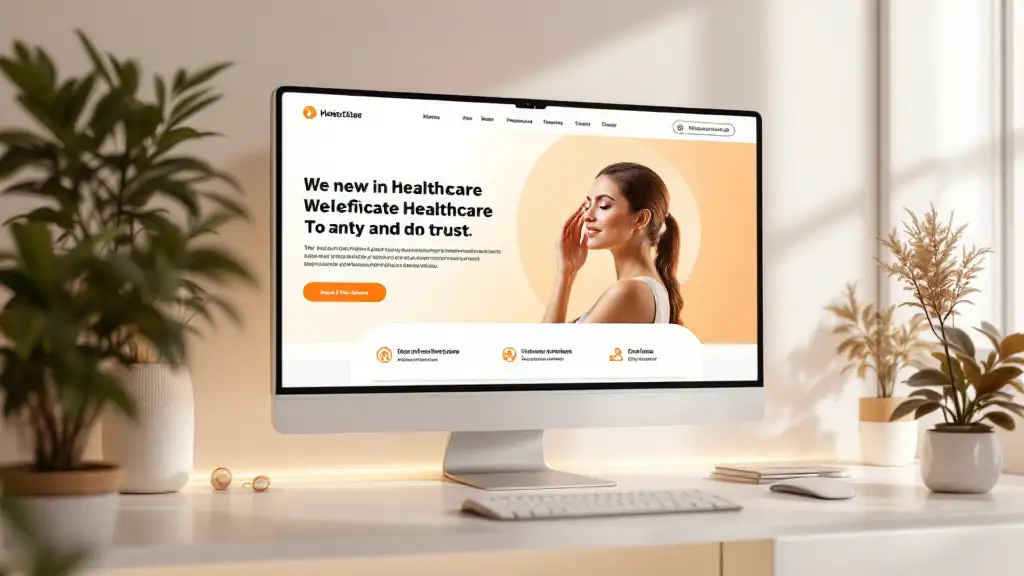Common Healthcare SEO Mistakes to Avoid
Unlocking Success: Avoid These Healthcare SEO Pitfalls


Common Healthcare SEO Mistakes to Avoid
Understanding the Critical Role of SEO in Healthcare
In today’s digital age, a robust online presence is essential for healthcare providers aiming to attract and retain patients. Search Engine Optimization (SEO) is a powerful tool that enhances visibility on search engines, helping potential patients find the right healthcare services quickly and conveniently. However, many healthcare practices fall into common SEO pitfalls that can undermine their online efforts. This article explores the most prevalent mistakes to avoid, ensuring your healthcare website ranks higher and reaches the right audience effectively.
The Foundation: Proper Keyword and Local SEO Strategies

How is SEO used in healthcare?
Healthcare SEO focuses on enhancing the online presence of medical practices to attract local patients actively searching for healthcare services. This involves optimizing website content with relevant keywords, structuring the site efficiently, and employing local SEO tactics like location-specific keywords and managing Google My Business profiles. The goal is to rank higher in search results for targeted queries, which increases visibility and credibility. Good SEO practices help practices to be easily discovered by prospective patients, fostering trust and competitive advantage. Additionally, healthcare SEO is a cost-effective, long-term marketing approach that complements other digital strategies.
Why is keyword research important?
Proper keyword research is fundamental because it guides content creation and on-page optimization. By identifying the search terms most relevant to their services—especially those used by potential patients—medical websites can improve their chances of appearing in search results. Avoiding keyword stuffing and focusing on naturally incorporating targeted long-tail keywords helps attract highly relevant traffic. Keywords should reflect patient queries in plain language, making content more accessible while boosting search engine rankings.
Use of location-specific keywords
Local SEO is vital for healthcare providers aiming to attract nearby patients. Incorporating location-based keywords such as "dentist in Dallas" or "pediatrician Houston" helps your site appear in local search results. Creating dedicated pages for each location and mentioning local landmarks or community features further reinforces local relevance. This strategy increases visibility on Google Maps and local directories, making it easier for patients to find and choose your practice.
Consistency in contact information
Ensuring contact details—name, address, phone number (NAP)—are consistent across your website and all online platforms is crucial. Inconsistent or outdated information can confuse search engines and patients alike, reducing trust and rankings. Regularly verify contact information on your website, Google My Business profile, patient directories, and social media pages. Consistency in contact info reinforces your local presence and improves your chances of appearing prominently in local search results.
On-Page Optimization: The Key to Search Engine Visibility

Unique titles and meta descriptions
Creating unique and descriptive titles and meta descriptions for each webpage is essential. They help search engines understand the page content and improve click-through rates from search results. Avoid duplicate titles and descriptions to ensure each page stands out.
Proper use of header tags
Organizing content with header tags (H1, H2, H3) not only makes the page easier to read but also signals the structure to search engines. Use a clear hierarchy, with one H1 per page, and incorporate relevant keywords naturally in headers.
Image optimization with alt text
Including descriptive alt text for images helps search engines interpret visual content and improves accessibility. Use meaningful keywords where relevant, but avoid keyword stuffing. Proper alt tags also contribute to better rankings in image search results.
Natural keyword incorporation
Strategically placing relevant keywords within titles, headers, and content enhances SEO without compromising readability. Focus on long-tail keywords and phrases that match patient search intent, avoiding overuse which can be penalized.
Optimizing these on-page elements forms the foundation of effective medical SEO. They ensure your site is more understandable to search engines and accessible for users, ultimately boosting your website’s visibility in local and broader search results.
Website Structure and User Experience: Building a SEO-Friendly Environment

Fast-loading websites
A crucial aspect of SEO is ensuring your healthcare website loads quickly. Visitors tend to leave websites that take longer than three seconds to load, which increases bounce rates and negatively impacts search rankings. Techniques to improve site speed include optimizing images by compressing them, leveraging browser caching, and selecting hosting providers with fast server responses.
Mobile responsiveness
With a rising number of patients searching for healthcare information via smartphones, having a mobile-friendly website is essential. Responsive design allows your site to adapt seamlessly to different screen sizes, enhancing user experience and aligning with Google’s mobile-first indexing. A mobile-optimized site helps retain visitors and improves ranking signals.
Intuitive navigation
An easy-to-navigate website guides visitors effortlessly to the information they seek, reducing frustration and encouraging longer visits. Clear menus, logical page arrangements, and accessible contact options contribute to better user engagement. Internal linking strategies should be implemented thoughtfully to connect related pages without overdoing it, enhancing both usability and SEO.
Clear hierarchy of content
Structuring your website content with a logical hierarchy enables search engines to understand your site's structure better. Proper use of heading tags (H1, H2, H3) reflects the importance of content sections and improves readability for users. Well-defined content hierarchy ensures that vital pages are prioritized in search results, aiding in higher visibility.
| Aspect | Best Practices | Benefits |
|---|---|---|
| Speed | Optimize images, cache, choose reliable hosting | Reduce bounce rate, boost rankings |
| Mobile | Use responsive design, test across devices | Reach mobile users effectively |
| Navigation | Simplify menus, internal links | Enhance usability, improve indexing |
| Content | Use clear hierarchy, appropriate headings | Better crawlability, clearer user flow |
A website that combines fast performance, mobile responsiveness, intuitive navigation, and a clear content hierarchy creates a welcoming environment for visitors and search engines alike. Consistently maintaining these aspects can significantly improve your healthcare practice’s visibility online.
Content Strategy: Keep It Relevant, Fresh, and Patient-Centric
 Maintaining a strong content strategy is vital for a healthcare website's SEO success. Regularly updating the site with fresh blog posts, articles, and patient testimonials not only boosts search engine rankings but also positions your practice as a reliable health resource.
Maintaining a strong content strategy is vital for a healthcare website's SEO success. Regularly updating the site with fresh blog posts, articles, and patient testimonials not only boosts search engine rankings but also positions your practice as a reliable health resource.
Creating educational and engaging content tailored to patient needs helps build trust and encourages repeat visits. This can include information about common conditions, prevention tips, or new treatment options.
Avoiding duplicate or low-quality content is essential, as search engines favor original and valuable information. Publishing well-researched, trustworthy content from authoritative sources enhances credibility and supports high search rankings.
Including content from reputable sources, such as medical journals, official health organizations, and credentialed professionals, ensures accuracy and aligns with Google's E-E-A-T (Expertise, Authoritativeness, Trustworthiness) standards.
A consistent content update schedule keeps your site relevant and competitive, attracting and retaining visitors while improving visibility in local and broad search results.
Technical and Local SEO: Maximizing Online Visibility

Why is website security with HTTPS important?
Secure websites that use HTTPS protect patient data and foster trust. Search engines prioritize HTTPS-enabled sites, boosting rankings and reassuring visitors that their information is safe.
How does optimizing loading speed benefit your healthcare site?
Fast-loading websites enhance user experience and reduce bounce rates. Techniques like compressing images, leveraging browser caching, and choosing reliable hosting can ensure your site loads within three seconds, which is crucial for SEO.
How can claiming and managing your Google My Business profile improve local visibility?
By claiming and regularly updating your Google Business Profile, you make it easier for local patients to find your practice. Including accurate contact details, adding photos, sharing updates, and responding to reviews increases your chances of appearing in local search results.
What role do local keywords and local content creation play?
Adding location-specific keywords such as city or neighborhood names in your content, meta descriptions, and titles helps attract nearby patients. Creating local-focused articles or blog posts about community health topics also enhances regional relevance and search ranking.
Why is encouraging patient reviews essential?
Positive reviews influence your practice's reputation and are a significant factor in local SEO algorithms. Encouraging satisfied patients to leave feedback and responding promptly to all reviews build trust and improve your online standing.
| Strategy | Action Steps | Benefits |
|---|---|---|
| Secure Website with HTTPS | Implement SSL certificates, ensure all pages are HTTPS | Builds trust, improves rankings, protects data |
| Speed Optimization | Compress images, use caching, optimize code | Better user experience, higher ranking, reduced bounce rate |
| Google My Business Management | Claim profile, update info, add photos, respond to reviews | Increased visibility, local search dominance |
| Local Keyword Integration | Use city/region names in content and tags | Attracts nearby patients, improves local SEO |
| Patient Review Management | Encourage reviews, respond to feedback | Enhances reputation, boosts search rankings |
Staying current with your local SEO efforts by monitoring analytics and updating your strategies ensures ongoing success in attracting local patients.
Measuring Success and Staying Updated: The Ongoing SEO Journey
How can healthcare providers measure their SEO success?
To evaluate how well a medical website is performing in search engine rankings, healthcare providers should utilize tools like Google Analytics and Google Search Console. These platforms provide valuable insights into website traffic, user behavior, and keyword performance. By analyzing data such as page views, bounce rates, and average session duration, clinics can identify which content resonates most with visitors and adjust their strategies accordingly.
What key metrics should be monitored?
Monitoring critical metrics helps in understanding SEO effectiveness. Key indicators include bounce rate, which shows how quickly visitors leave the site; organic traffic, indicating the number of visitors arriving via search engines; and search rankings for targeted keywords. Tracking these metrics allows practices to recognize trends, evaluate the impact of content updates, and refine their SEO tactics.
Why is adapting to algorithm changes important?
Search engine algorithms frequently evolve, affecting how websites rank in search results. Staying updated with these changes is essential to maintain visibility. Regularly reviewing industry news and official algorithm updates helps practices adapt their strategies, such as updating keyword usage, improving site structure, or enhancing mobile and speed optimizations, ensuring sustained SEO success.
How can regular website audits support ongoing improvement?
Performing comprehensive website audits periodically helps identify SEO issues like broken links, slow load times, duplicate content, or missing meta tags. These audits facilitate necessary technical fixes, content improvements, and implementation of new best practices. Continuous updates and audits ensure the website remains optimized, relevant, and competitive in local and broader search results.
| Aspect | Action | Purpose | Tools/Methods |
|---|---|---|---|
| Analytics Monitoring | Track traffic, user behavior | Measure engagement and identify content gaps | Google Analytics, Search Console |
| Key Metrics | Focus on bounce rate, rankings | Assess overall SEO health | Dashboard reviews |
| Algorithm Updates | Stay informed on trends | Adjust strategies to maintain rankings | Industry blogs, Google updates |
| Site Audits | Conduct technical checks | Fix issues impacting SEO | Semrush, Ahrefs, Screaming Frog |
Staying proactive with analytics, metrics, and technological updates is essential for healthcare practices aiming for long-term SEO success.
Achieving Optimal Healthcare SEO Results
Avoiding common mistakes in healthcare SEO requires a comprehensive, ethical, and patient-focused approach. By aligning strategies with best practices—such as rigorous keyword research, excellent on-page optimization, a user-friendly website structure, high-quality content, and diligent technical and local SEO efforts—healthcare providers can significantly improve their search engine rankings. Continual monitoring and adaptation to the evolving digital landscape are essential for sustained success. Remember, the golden rule remains: prioritize user value and relevance over manipulative tactics, ensuring your healthcare website remains credible, accessible, and highly visible in search results.
References
- 7 Common Medical SEO Mistakes (And How to Avoid Them)
- Avoiding Medical SEO Mistakes: A Short Guide
- Ten Common SEO Mistakes Healthcare Practices Should Avoid
- 10 Powerful Healthcare SEO Mistakes Guidelines To Boost Your ...
- 3 B2B Healthcare SEO Strategy Mistakes (& How to Cure Them)
- Common Healthcare Marketing Mistakes & How to Avoid Them - CMG
- SEO Mistakes in the medical industry - AJ Creative Studios
- SEO For Medical Practices: 7 Mistakes To Avoid
- 4 SEO Mistakes Healthcare Websites Still Make | Digital 38
- Medical Website SEO Mistakes - How To Get Good SEO Rankings







